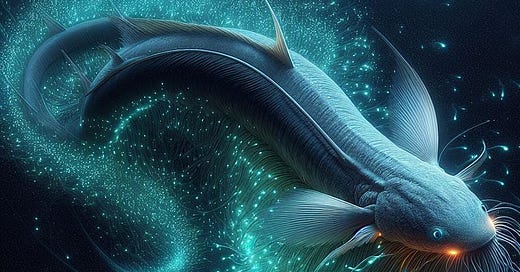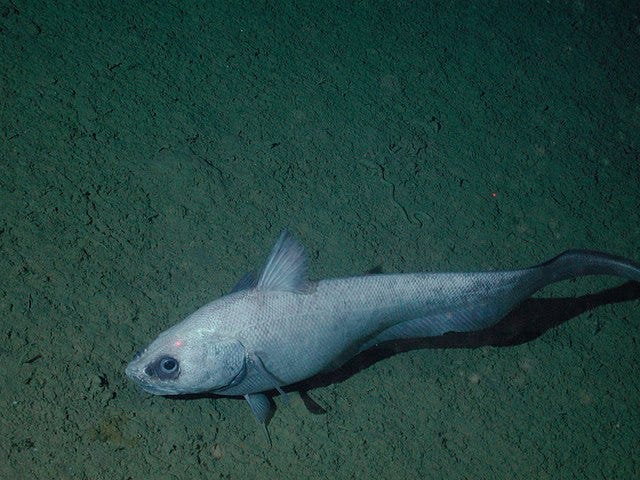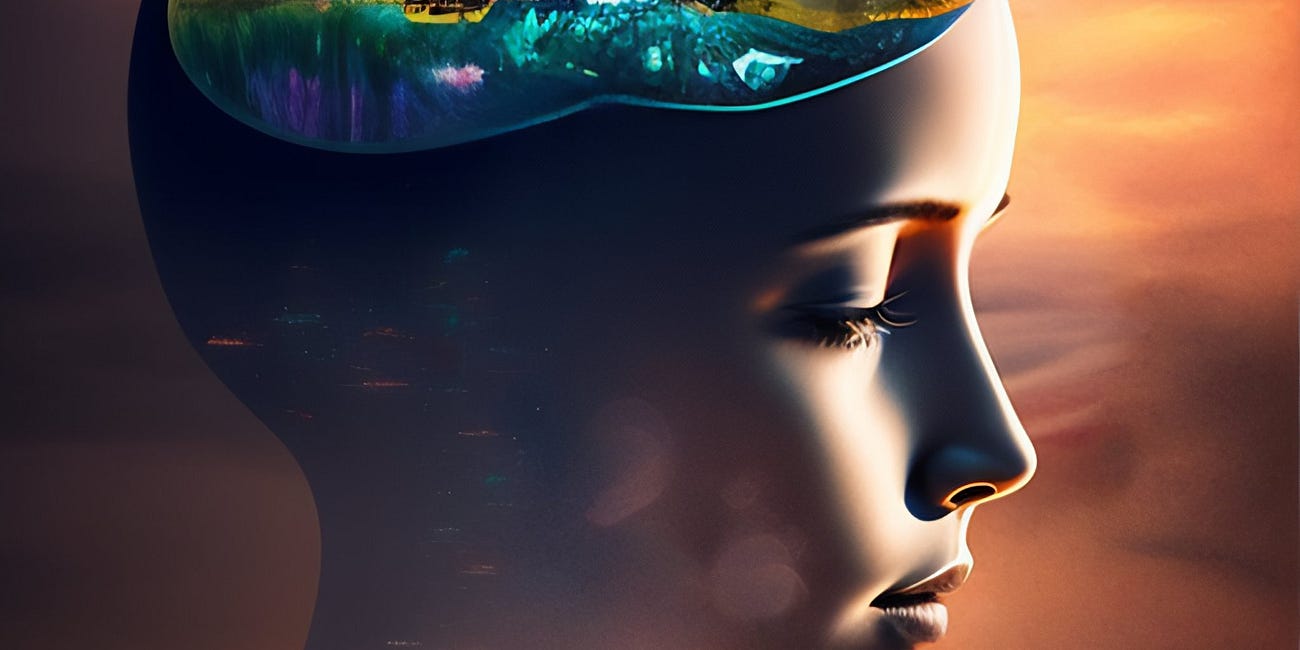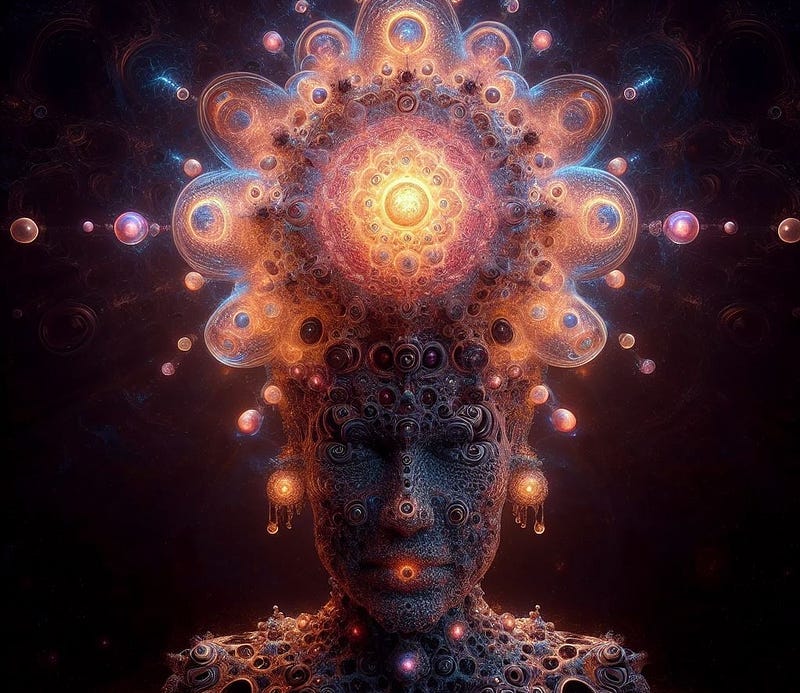The Bioluminescent Bacteria Inside the Rattail Fish: A Philosophical Reflection.
Bioluminescence as Vedanta Teaching Metaphor: Overcoming Negative Emotions through Pratipakṣa-Bhāvanā.
Rattail Fish and Bioluminescent Bacteria. Image by Author.
In the kingdom of the immense depths of the oceans, where there exists not day nor night, swim the mysterious creatures of the abysses. Rattails with vigilant eyes, decorated with reflections of constellations on the skin.
Rattails are elongated, eel-like fish with a long, slender body and a tapering tail. They are part of the Macrouridae family and typically have a small mouth with numerous, small teeth, and they are found in all oceans at depths ranging from shallow waters to the deep sea.
The Macrouridae family is the largest family of rattails, with over 500 species. They are found in all oceans, except the Arctic and Antarctic, and they range in size from small, eel-like fish to large, torpedo-shaped fish. Macrourids are opportunistic predators that feed on a variety of prey, including squid, fish, and crustaceans.
Rattails bellies shine with thousands of blue lights, a marine galaxy generated by small luminous beings. They are colonies of Aliivibrio, bioluminescent bacteria large one-thousandth of a millimetre.
Coryphaenoides leptolepis is a rattail, specifically a member of the family Macrouridae. Rattails are elongated, eel-like fish with a long, slender body and a tapering tail. Photo taken at 3158 meters water depth at California, Davidson Seamount. Image by WikiCommons.
Through an ancestral biochemical language, they exchange energy and information with the cells of the fish. A quantum dance that generates life from water, and light from darkness.
Learn, Unlearn, Relearn: The Path to Progress.
Podcast with Jayashankar Krishnamurthy, Director of the Vedanta Institute of Hyderabad, India. Topic: Learn, Unlearn, Relearn. "The illiterate of the 21st century will not be those who cannot read and write, but those who cannot learn, unlearn, and relearn."
Now, why do the bacteria and the rattail fish benefit from this relationship?
The rattail fish and the bacteria have a mutual symbiotic relationship where each benefits from the other. The Allivibrio bacteria live inside special light organs in the rattail fish. The bacteria can produce bioluminescence, or light, through a chemical reaction.
The bacteria benefit because they have a safe, protected place to live inside the fish's light organs. They get nutrients from the fish for their growth and survival. The rattail fish benefits greatly from the bacteria's ability to produce light. The fish can use the light from the bacteria to illuminate itself. This bioluminescence acts as a form of camouflage called counterillumination. It helps the dark silhouettes of the fish blend into the background light from above, invisible to both prey and predators looking up from below.
Without expending any energy of its own, the fish gains a defensive form of camouflage just by hosting the bacteria in its light organs. This camouflage provides the fish with better chances of survival and food by helping it hunt prey and avoid being hunted.
Just as the ancient Indian scripture Īśāvāsya Upaniṣad states:
“From the thickest darkness, we bring forth the light”.
Imagine that inside every Aliivibrio bacterium, there is a magical factory called lux operon. This factory has a complicated assembly line with conveyor belts, robots and machinery. The conveyor belts carry the instructions, written in the DNA code, to the various departments of the factory. In the “transcription” department the instructions are read and transformed into a message to deliver. In the “translation” department the message is used to build special proteins, like luciferase.
Timelapse — Aliivibrio fischeri — Youtube channel by Christophe Veuillot.
When the light goes out in the factory because it is dark, an alarm goes off that starts production. Luciferase and other proteins are sent to the “luminescence” department. Here the magic happens: luciferase makes luciferin shine like a fairy godmother lights Cinderella’s magic wand.
It is a spectacle of light and colours, which transforms darkness into a bright galaxy on the fish’s skin. The lux operon factory is truly a wonder of nature!
And that light illuminates the paths of the abyss for the rattails, allowing them to see, feed and reproduce despite the eternal darkness that surrounds them. The Aliivibrio bacteria have learned to secrete photons through special enzymatic reactions, lighting their “molecular third eye” that pierces the veil of darkness.
These microbes and their special relationship with rattail fishes could be a special metaphor for Pratipakṣa-Bhāvanā, a Vedantic transformation of adversities into spiritual means.
The very absence of sunlight in the abysses, a deadly enemy for any earthly creature, is used here as a stimulus for an alternative vision. A quantum bioluminescence that defies physical laws and generates life instead of extinguishing it.
Pratipakṣa-Bhāvanā consists in cultivating a thought or attitude opposite to the negative thoughts or emotions that arise in our mind. For example, if we feel jealous of someone, we can cultivate a positive thought or attitude towards that person instead of remaining focused on our negative emotions. This practice helps us develop a more balanced and detached perspective on life, allowing us to respond to situations with greater clarity and wisdom.
Now, let’s think.
If these bioluminescent microbes can generate so much wonder, what may ever come from the depths of our soul, if only we open up to the inner light? What hidden treasures may be revealed, what unseen beauties may shine, if we tune in to our innate ability to see beyond the veil of appearance?
Rattail Fish, Bioluminescent Bacteria and Mysticism. Image by Author.
Our eternal light is the Atman but I like to immerse myself in a rêverie of mine according to which even inside us exist “bioluminescent organisms” hidden, ready to light up if nourished by constant meditation. We can generate that same light by dissolving the ego into the quantum void from which the universe emerges, according to the words of the Ṛṣi Agastya:
“Darkness is your oil lamp; its wick is your ego. Dissolve your ego in the Absolute and you will see your consciousness shine with a thousand suns.”
Darkness is your oil lamp. Image by Author.
In the oil lamp, the lit wick allows the oil to burn in a controlled way and generate light. So the wick is necessary for the lamp to light up. Without it, the oil remains inert. But in the metaphor with the ego, the “wick” must be “extinguished” to allow the inner light to emerge.
This apparent paradox makes sense. Because:
The ego is not the source of our inner light, but a filter that inhibits it and contains it. “Extinguishing” the ego means removing this filter, this veil, which hides our true luminous nature. It is as if the ego makes the lamp wick opaque instead of lighting it. So it must be eliminated, so that our light can shine.
Every adversity can become an inspiration if we remember to breathe, to observe that perpetual rhythm that pulses behind the veils of appearance. Darkness reveals light, just as the ebb of the waves precedes powerful new tides. Thus the difficulties of life precede each of our inner transformations.
The rattails and their bacteria remind us of all this. Their harmonious bioluminescent dance in the abyss is a silent reminder. An ancient teaching that we can always choose to embody: transforming every challenge into fuel to make our innate eternal and immutable inner light shine.
Tat Tvam Asi — “Thou are That”.
I have woven tales to share, for any who care to read them. My books await you on Google Books. Check also my stories on Medium.com.
I would be honoured if you considered subscribing to the Premium Contents of my Vedanta Substack and leaving feedback, comments, and suggestions both on this page and by writing to me at cosmicdancerpodcast@gmail.com.
Thank you for your precious attention.








